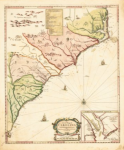Governor: 1689-1690
See also: John Gibbs (Gibbes, Gibs), Gibbs's Rebellion

John Gibbs became chief executive when Governor Seth Sothel was banished from the Albemarle region. When Philip Ludwell arrived with his governor’s commission, Gibbs did not give up the governorship and caused an uprising. Gibbs’s birth date and parents are unknown. The Gibbs family from Devonshire, England, was active in colonization. Gibbs was related to Lords Proprietor Christopher Monck. His wife was apparently named Mary; they had a son and a daughter. After being nominated by Monck, Gibbs received the rank of Cacique in October 1682, making him a member of the Carolina nobility based upon the Fundamental Constitutions. In 1683 the proprietors authorized officials in the southern colony (now South Carolina) to provide Gibbs with 3,000 acres of rent-free land, but he evidently did nothing with the land. Prior to becoming governor, Gibbs was residing in Virginia.
With Sothel’s banishment in the fall of 1689, Gibbs was the Carolina nobility’s highest-ranking member, which entitled him to claim Albemarle’s governorship. Gibbs was unable to enjoy the chief executive’s office for long because Philip Ludwell arrived in the spring of 1690 with a governor’s commission from the proprietors. Ludwell set up his government, but Gibbs was determined not to leave the governorship. On June 2, 1690, Gibbs issued a declaration claiming his right to the governorship based on the Fundamental Constitutions and called on the people to obey him. Gibbs referred to Ludwell as a “rascal, impostor, and usurper” and stated his readiness to fight anyone to keep Ludwell from the governor’s office.
On July 6, 1690, Gibbs and about fifteen men entered the Pasquotank precinct court and broke it up. He forbade the holding of a court without a commission from him. The force seized two magistrates and took them as prisoners to Gibbs’s house. Next, Gibbs moved the prisoners to his Virginia plantation protected by a force of around eighty men. Upon news of Gibbs’s action, the Albemarle council sent the militia to stop this rebellion. However, the militia refused to enter Virginia without permission from that colony’s government.
Ludwell sought assistance from Virginia’s lieutenant governor, Francis Nicholson, in settling the situation. Nicholson secured the release of the prisoners and persuaded Ludwell and Gibbs to go before the Lords Proprietors. Both men went to England and presented their views before the proprietors. The proprietors upheld Ludwell’s commission. By 1693 the Fundamental Constitutions were suspended removing Gibbs’s right to claim the governorship. Yet, Gibbs was still asserting his right to the governorship in 1695. The Lords Proprietors again repudiated Gibbs writing to Ludwell, “He is not a Governor nor can be, unless his power is derived from us.” It is not known if Gibbs ever returned to Albemarle. He designated attorney Edward Mayo to dispose of his concerns. From 1691 through 1694 Mayo made several appearances in court on Gibbs’s behalf. By the late 1690s and early 1700s, Gibbs’ deserted land was being redistributed to others. Gibbs date of death is unknown.